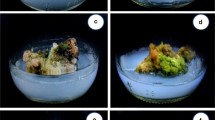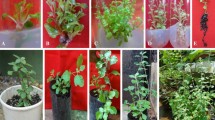Abstract
This is the first report on in vitro propagation and phytochemical assessment of Aconitum ferox (Ranunculaceae), a threatened medicinal plant of Sikkim Himalaya. A simple and efficient in vitro propagation protocol through indirect shoot organogenesis has been established for A. ferox using root tip explants. Murashige and Skoog (MS) medium supplemented with 2.26 µM 2, 4-dichlorophenoxyacetic acid (2, 4-D) was found to be the best medium to induce and maintain the callus. Different concentrations and combinations of plant growth regulators (PGRs) were tested for in vitro shoot proliferation. Adventitious shoots were produced from callus when it was transferred to MS medium supplemented with N6-benzylaminopurine (BAP). The synergistic incorporation of 3 µM indole-3-acetic acid (IAA) in 6 µM BAP containing medium-induced plantlets with well-developed roots and shoots. However, the best rooting responses were observed in shoots placed on paper bridge in liquid MS medium supplemented with 3 µM IAA + 6 µM BAP. The plantlets were successfully acclimatized in ex vitro conditions with 70% survival rate. Additionally, root extract of in vitro-raised plants showed antioxidant activity closer to wild plants. The study thus signifies the effectiveness of in vitro technique for A. ferox propagation and provides a method for sustainable utilization of this high-value medicinal plant at commercial scale in pharmaceutical industries.


Similar content being viewed by others
References
Badola HK, Aitken S (2010) Potential biological resources for poverty alleviation in Indian Himalaya. Biodiversity 11(3–4):8–18. https://doi.org/10.1080/14888386.2010.9712659
Ved DK, Kinhal GA, Haridasan K, Ravikumar K, Ghate U, Sankar RV, Indresha JH (2003) Conservation assessment and management prioritisation for the medicinal plants of Arunachal Pradesh. FRLHT, Bangalore, India, Assam, p 120
Pradhan BK, Badola HK (2015) Swertia chirayta, a threatened high-value medicinal herb: microhabitats and conservation challenges in Sikkim Himalaya, India. Mount Res Dev 35(4):374–381. https://doi.org/10.1659/MRD-JOURNAL-D-14-00034.1
Nayar MP, Sastry APK (1990) Red data book of Indian plants. Botanical Survey of India, Calcutta
Chakravarty HL, Chakravarti D (1954) Indian aconites. Econ Bot 8:366–376
Rawat JM, Agnihotri RK, Nautiyal S, Rawat B, Chandra A (2013) In vitro propagation, genetic and secondary metabolite analysis of Aconitum violaceum Jacq.: a threatened medicinal herb. Acta Physiol Plant 35:2589–2599. https://doi.org/10.1007/s11738-013-1294-x
Uprety Y, Asselin H, Boon EK, Yadav S, Shrestha KK (2010) Indigenous use and bio-efficacy of medicinal plants in the Rasuwa district, central Nepal. J Ethnobiol Ethnomed 6(1):3. https://doi.org/10.1186/1746-4269-6-3
Pradhan BK, Badola HK (2008) Ethnomedicinal plant use by Lepcha tribe of Dzongu valley, bordering Khangchendzonga Biosphere Reserve, in North Sikkim, India. J Ethnobiol Ethnomed 4:22. https://doi.org/10.1186/1746-4269-4-22
Sheokand A, Sharma A, Gothecha VK (2012) Vatsanabha (Aconitum Ferox): from Visha to Amrita. Int J Ayurvedic Herb Med 2(3):423–426. https://doi.org/10.7897/2277-4343.085278
Hanuman JB, Katz A (1994) New lipo norditerpenoid alkaloids from root tubers of Aconitum ferox. J Nat Prod 57:105–115. https://doi.org/10.1021/np50103a015
Hanuman JB, Katz A (1994) Diterpenoid alkaloids from Ayurvedic processed and unprocessed Aconitum ferox. Phytochem 36:1527–1535. https://doi.org/10.1016/S0031-9422(00)89756-3
Purushothman KK, Chandrasekharan S (1974) Alkaloids of Aconitum ferox. Phytochem 13:1975–1977. https://doi.org/10.1016/0031-9422(74)85128-9
Bhatt D, Joshi GC, Kumar R, Tewari LM (2014) Phytosociological features and categorization of A. heterophyllum Wall. ex Royle and A. ferox Wall. ex Ser. in Kumaun Himalaya. J Ecol Nat Env 6(3):111–118. https://doi.org/10.5897/jene2013.0395
Cervelli R (1987) In vitro propagation of Aconitum noveboracense and Aconitum napellus. Hort Sci 22(2):304–305
Hatano K, Kamura K, ShoyamaY NishiokaI (1988) Clonal multiplication of Aconitum carmichaeli Debx. by tip tissue culture and alkaloid contents of clonally propagated plants. Planta Med 54:152–154. https://doi.org/10.1055/s-2006-962375
Giri A, Ahuja PS, Kumar PVA (1993) Somatic embryogenesis and plant regeneration from callus culture of Aconitum heterophyllum Wall. Plant Cell Tiss Organ Cult 32:213–218. https://doi.org/10.1007/BF00029845
Chandra B (2003) Studies on propagation, agrotechnology and phytochemical evaluation of some alpine medicinal plants of Himalayan region. Ph.D. thesis, Kumaun University, Nainital, p 148
Murashige T, Skoog F (1962) A revised medium for rapid growth and bioassays with tobacco cultures. Physiologia Plant 15:473–497. https://doi.org/10.1111/j.1399-3054.1962.tb08052.x
Meda A, Lamien CE, Romito M, Millogo J, Nacoulma OG (2005) Determination of the total phenolic, flavonoid and proline contents in Burkina Fasan honey, as well as their radical scavenging activity. Food Chem 91(3):571–577. https://doi.org/10.1016/j.foodchem.2004.10.006
Lamaison JLC, Carnet A (1990) Contents in main flavonoid compounds of Crataegus monogyna Jacq. and Crataegus laevigata (Poiret) DC flowers at different development stages. Pharmaceutica Acta Helvetica 65:315–320
Re R, Pellegrini N, Proteggente A, Pannala A, Yang M, Evans C (1999) Antioxidant activity applying an improved ABTS radical cation decolorization assay. Free Radical Biol Med 26:1231–1237 PMID: 10381194
Pandey H, Nandi SK, Kumar A, Palni UT, Chandra B, Palni LMS (2004) In vitro propagation of Aconitum balfourii Stapf; an important aconite of Himalayan alpine. J Hort Sci Biotech 21:69–84. https://doi.org/10.1080/14620316.2004.11511733
Belwal NS, Kamal B, Sharma V, Gupta S, Dobriyal AK, Jadon VS (2016) Production of genetically uniform plant from shoot tips of Aconitum heterophyllum Wall.- a critically endangered medicinal herb. J Hortic Sci Biotechnol. https://doi.org/10.1080/14620316.2016.1184434
Skoog F, Miller CO (1957) Chemical regulation of growth and organ formation in plant tissues cultured in vitro. Symp Soc Exp Biol 11:118–130 PMID:13486467
Gordon SP, Chickarmane VS, Ohno C, Meyerowitz EM (2009) Multiple feedback loops through cytokinin signaling control stem cell number within the Arabidopsis shoot meristem. Proc Natl Acad Sci USA 106:16529–16534. https://doi.org/10.1073/pnas.0908122106
Singh M, Chaturvedi R (2012) Screening and quantification of an antiseptic alkylamide, spilanthol from in vitro cell and tissue cultures of Spilanthes acmella Murr. Ind Crop Prod 36:321–328. https://doi.org/10.1016/j.indcrop.2011.10.029
Pandey A, Tamta S (2014) In vitro propagation of the important tasar Oak (Quercus serrata Thunb.) by casein hydrolysate promoted high frequency shoot proliferation. J Sust For 33:590–603. https://doi.org/10.1080/10549811.2014.912587
Brijwal L, Pandey A, Tamta S (2015) In vitro propagation of the endangered species Berberis aristata DC. via leaf-derived callus. Vitro Cell Dev Biol- Plant 51:1–11. https://doi.org/10.1007/s11627-015-9716-7
Hesami M, Daneshvar MH, Yoosefzadeh-Najafabadi M, Alizadeh M (2017) Effect of plant growth regulators on indirect shoot organogenesis of Ficus religiosa through seedling derived petiole segments. J Genet Eng Biotechnol 16:175–180. https://doi.org/10.1016/j.jgeb.2017.11.001
Zhu WT, Du JZ, Sun HB, Jiang SY, Chen XJ, Sun H, Zhou Y, Wang HL (2018) In vitro propagation of an endemic and endangered medicinal plant Notopterygium incisum. Plant Cell Tiss Organ Cult. https://doi.org/10.1007/s11240-018-1474-x
Pereira JA, Oliveira I, Sousa A, Valentão P, Andrade PB, Ferreira IC, Ferreres F, Bento A, Seabra R, Estevinho L (2007) Walnut (Juglans regia L.) leaves: phenolic compounds, antibacterial activity and antioxidant potential of different cultivars. Food Chem Toxicol 45(11):2287–2295. https://doi.org/10.1016/j.fct.2007.06.004
Covelo F, Gallardo A (2001) Temporal variation in total leaf phenolics concentration of Quercus robur in forested and harvested stands in Northwestern Spain. Canad J Bot 79(11):1262–1269. https://doi.org/10.1139/b01-109
Munir N, Ijaz W, AltafI Naz S (2014) Evaluation of antifungal and antioxidant potential of two medicinal plants: Aconitum heterophyllum and Polygonum bistorta. Asian Pac J Tropical Biomed 4:639–643. https://doi.org/10.12980/APJTB.4.201414B182
Rameashkannan MV, Riyaz AP, Mudasir AM (2013) Phytochemical, antioxidant and antimicrobial evaluation of Aconitum kashmiricum Stapf ex Coventry, a critically endangered medicinal herb. Indo Am J Pharm Res 4(1):2231–6876. https://doi.org/10.1044/1980-iajpr.01125
Acknowledgements
The authors are thankful to the Director, G.B. Pant National Institute of Himalayan Environment and Sustainable Development (GBPNIHESD), and to the Ministry of Environment Forest and Climate Change, (MoEF & CC), Govt. of India, New Delhi, for providing necessary facilities. Financial support from GBPNIHESD, Kosi-Katarmal, Almora, MoEF & CC (In House Project No. 8) is gratefully acknowledged. Mr. Mohan Thapa, GBPNIHESD, Sikkim Regional Centre is acknowledged for his help during experimentation.
Author information
Authors and Affiliations
Corresponding author
Ethics declarations
Conflict of interest
The authors declare that they have no conflict of interest to publish this manuscript.
Additional information
Publisher's Note
Springer Nature remains neutral with regard to jurisdictional claims in published maps and institutional affiliations.
Significance Statement This is the first report on in vitro propagation and phytochemical assessment of A. ferox. Study provides a sustainable technique for germplasm conservation and commercial cultivation of this threatened and high-value medicinal plant of Himalaya.
Rights and permissions
About this article
Cite this article
Singh, M., Chettri, A., Pandey, A. et al. In Vitro Propagation and Phytochemical Assessment of Aconitum ferox Wall: A Threatened Medicinal Plant of Sikkim Himalaya. Proc. Natl. Acad. Sci., India, Sect. B Biol. Sci. 90, 313–321 (2020). https://doi.org/10.1007/s40011-019-01104-x
Received:
Revised:
Accepted:
Published:
Issue Date:
DOI: https://doi.org/10.1007/s40011-019-01104-x




